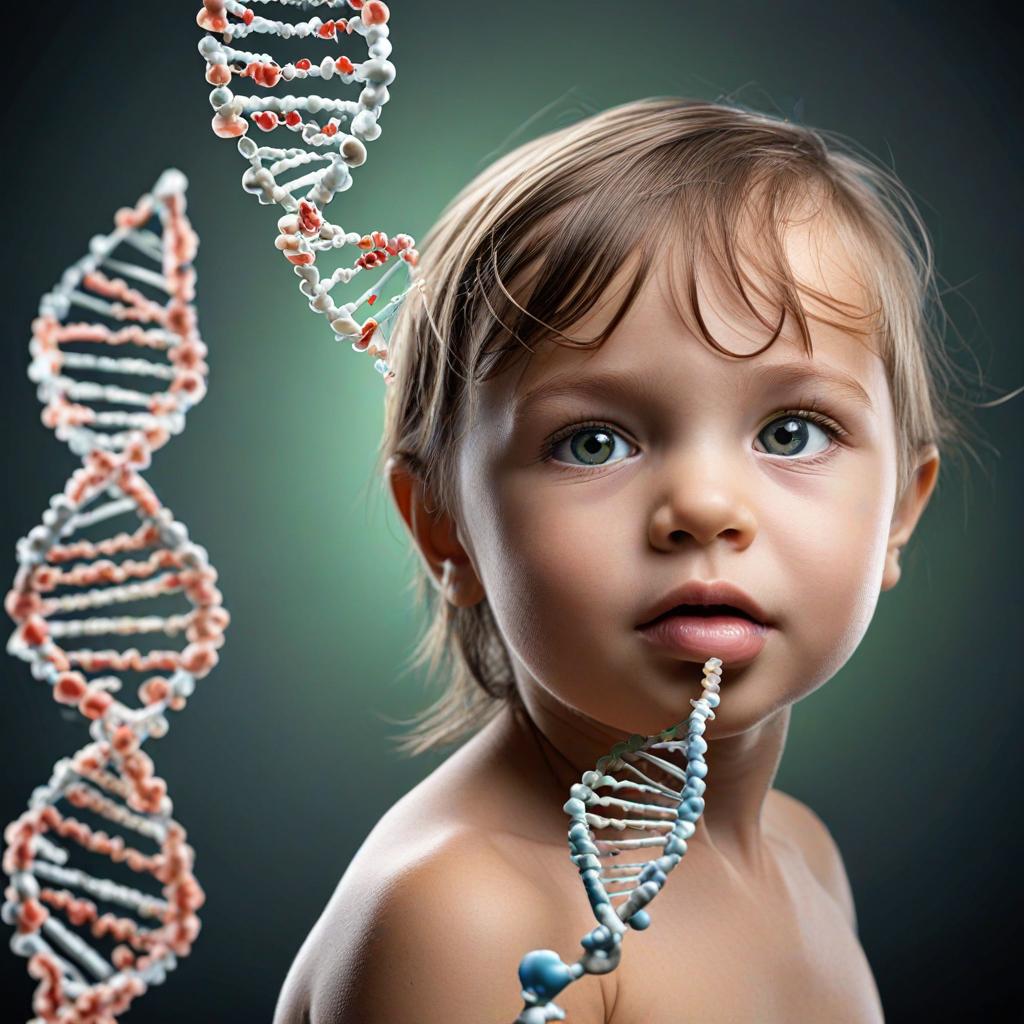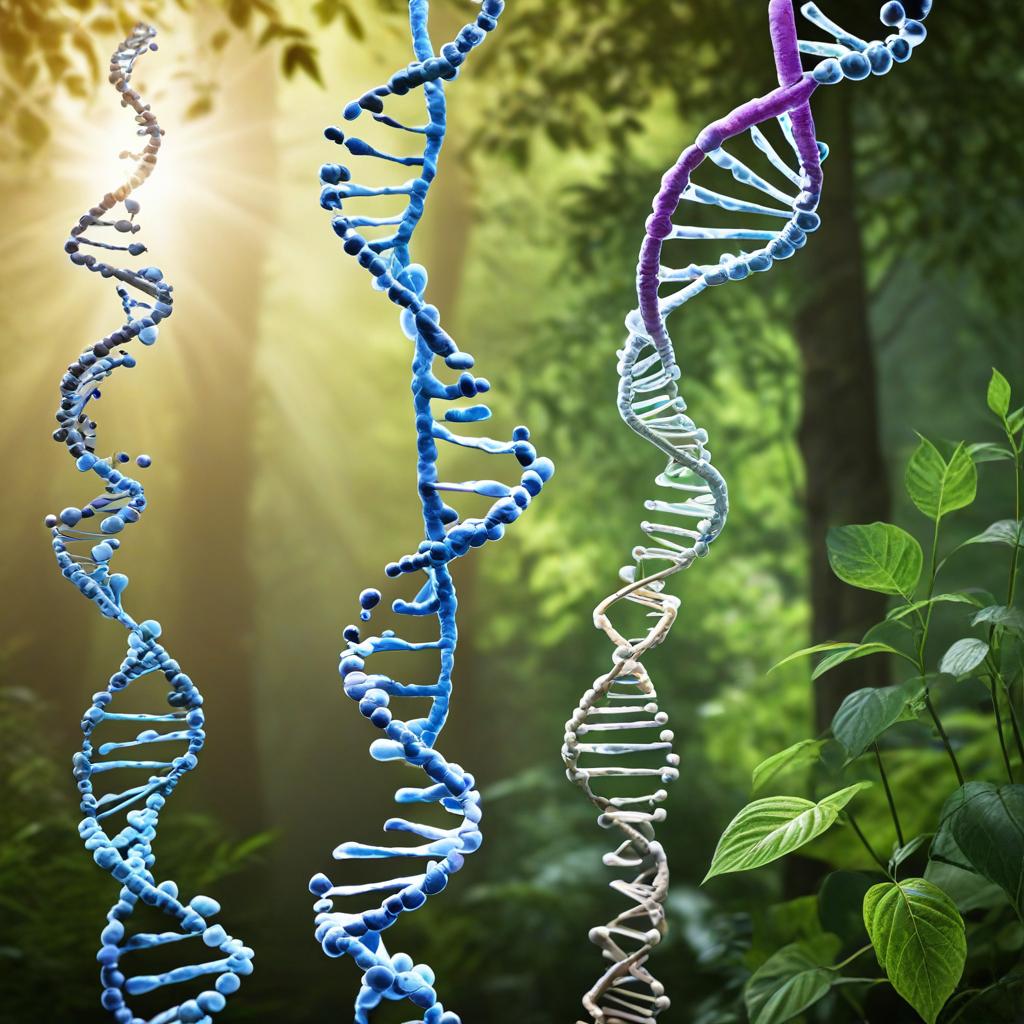The Intricate Dance of Genetics, Environment, and Human Development
Human development is a complex process influenced by an interplay of  , environment, and individual experiences. From the moment of conception, a person’s genetic makeup starts to shape their biological and psychological traits, contributing to their unique personality, behavior, and emotional states. Understanding how these elements interact can provide insights into how we function and how we can optimize our well-being.
, environment, and individual experiences. From the moment of conception, a person’s genetic makeup starts to shape their biological and psychological traits, contributing to their unique personality, behavior, and emotional states. Understanding how these elements interact can provide insights into how we function and how we can optimize our well-being.
The Foundation: Genetics and Cellular Development
1. Genetics: The Blueprint At conception, sperm and egg merge to form a zygote, carrying a complete set of DNA from both parents. This genetic blueprint influences various aspects of the developing organism:
- Biology: Genes determine physical characteristics, organ development, and cellular functions.
- Psychology: Genetic predispositions can influence temperament, cognitive abilities, and susceptibility to mental health disorders.
2. Cellular Development and Function Cells, the building blocks of life, follow genetic instructions to form tissues and organs. The process includes:
- Cell Differentiation: Cells specialize to perform specific functions.
- Cellular Memory: Cells retain information about their identity and function, which is crucial for maintaining the body’s integrity.
Environmental Influences and Epigenetics
While genetics lay the groundwork, the environment significantly shapes an individual’s development. Key environmental factors include:
- Nutrition: Essential for cellular function and overall health.
- Exposure to Toxins: Can alter cellular processes and lead to developmental issues.
- Social Interactions: Crucial for psychological and emotional development.
Epigenetics: This field studies how environmental factors influence gene expression without changing the DNA sequence. Epigenetic changes can be passed down to future generations, demonstrating how lifestyle and environment can have lasting impacts.
The Brain: A Chemical Symphony
The brain, a central player in regulating emotions and behaviors, relies on chemical messengers to communicate:
- Neurotransmitters: Chemicals like serotonin, dopamine, and norepinephrine transmit signals between neurons.
- Hormones: Substances like cortisol (stress hormone) influence mood and energy levels.
Emotional States and Chemical Reactions
1. Stress and Anxiety When a person experiences stress or anxiety, the body undergoes several chemical changes:
- Activation of the Hypothalamic-Pituitary-Adrenal (HPA) Axis: This leads to the release of cortisol and adrenaline.
- Neurotransmitter Imbalance: Levels of serotonin and dopamine may fluctuate, affecting mood and anxiety levels.
2. Depression Depression is often linked to deficiencies or imbalances in neurotransmitters such as serotonin, dopamine, and norepinephrine. Chronic stress can exacerbate these imbalances.
3. Anger Anger triggers the release of adrenaline and noradrenaline, preparing the body for a ‘fight or flight’ response. This can lead to increased heart rate, blood pressure, and energy levels.
Evolutionary Perspective
From an evolutionary standpoint, these emotional responses have survival benefits:
- Stress and Anxiety: Heighten alertness and readiness to respond to threats.
- Depression: May have historically functioned as a mechanism to conserve energy during adverse conditions.
- Anger: Provides the necessary energy to defend against threats or assert dominance.
Modulating Chemical Activities for Well-being
To maintain balance and promote well-being, various strategies can be employed:
1. Lifestyle Interventions
- Diet: Consuming a balanced diet rich in essential nutrients supports brain health and neurotransmitter production.
- Exercise: Regular physical activity increases the release of endorphins and improves mood.
- Sleep: Adequate sleep is crucial for neurotransmitter regulation and overall mental health.
2. Psychological Interventions
- Cognitive Behavioral Therapy (CBT): Helps reframe negative thought patterns and reduce stress and anxiety.
- Mindfulness and Meditation: Practices that can reduce cortisol levels and promote relaxation.
3. Medical Interventions
- Medication: Antidepressants and anxiolytics can help restore neurotransmitter balance.
- Supplements: Omega-3 fatty acids, B vitamins, and magnesium support brain health.
4. Social Support
- Community and Relationships: Strong social connections provide emotional support and can buffer against stress and anxiety.
The Symphony of Human Development: An Exploration Beyond Genetics and Environment
Human development is an intricate tapestry woven from the threads of our genetic blueprint, environmental influences, and individual experiences. Each strand contributes uniquely to the formation of our physical, psychological, and emotional selves. Delving deeper into these factors reveals a richer understanding of how we become who we are and how we can maintain our well-being.
The Genetic Orchestra: Harmony and Variation
1. Genetic Predispositions and Variability Genetic diversity ensures that no two individuals are identical, even among identical twins. Variability in genes affects:
- Physical Traits: Unique combinations of alleles determine features such as height, eye color, and susceptibility to diseases.
- Behavioral Tendencies: Variations in genes related to neurotransmitter function can influence risk-taking behaviors, social interactions, and emotional resilience.
2. Gene-Environment Interactions Our genetic predispositions interact dynamically with environmental factors, shaping our development:
- Genetic Susceptibility: Certain genetic configurations may make individuals more susceptible to environmental influences, such as stress or toxins.
- Protective Genes: Some genes provide resilience against adverse conditions, aiding in recovery and adaptation.
The Role of Epigenetics in Development
1. Mechanisms of Epigenetic Changes Epigenetic modifications involve chemical changes to DNA or histones, affecting gene expression without altering the underlying genetic code:
- DNA Methylation: The addition of methyl groups can silence genes, affecting their expression.
- Histone Modification: Changes to histone proteins can alter the accessibility of DNA for transcription, influencing gene activity.
2. Transgenerational Epigenetic Inheritance Environmental factors can cause epigenetic changes that are passed down through generations:
- Parental Influence: The experiences of parents, such as exposure to stress or nutrition, can influence the epigenetic markers in their offspring.
- Evolutionary Adaptations: Epigenetic changes can contribute to rapid adaptation to environmental changes, offering a mechanism for evolution beyond genetic mutations.
The Brain’s Chemical Ballet
1. Neuroplasticity and Development The brain’s ability to reorganize itself by forming new neural connections is critical for learning and adaptation:
- Synaptic Plasticity: The strengthening or weakening of synapses in response to activity patterns shapes memory and learning.
- Neurogenesis: The generation of new neurons, particularly in the hippocampus, plays a role in emotional regulation and cognitive function.
2. The Gut-Brain Axis The bidirectional communication between the gut and the brain significantly impacts mental health:
- Microbiome Influence: Gut bacteria produce neurotransmitters and other signaling molecules that can affect brain function and mood.
- Nutrient Absorption: Efficient digestion and absorption of nutrients support optimal brain function and emotional stability.
Emotional States: Biochemical Pathways
1. Fear and the Amygdala The amygdala plays a central role in the processing of fear and threat detection:
- Neurotransmitter Release: Activation of the amygdala triggers the release of norepinephrine, preparing the body for a rapid response.
- Memory Encoding: Fearful experiences are encoded strongly in memory, aiding in survival by enhancing future threat detection.
2. Joy and the Reward System The brain’s reward system, primarily involving the nucleus accumbens, is crucial for experiencing pleasure and motivation:
- Dopamine Pathways: The release of dopamine reinforces rewarding behaviors and is essential for motivation and goal-directed activity.
- Endogenous Opioids: The release of endorphins contributes to feelings of euphoria and pain relief.
The Evolutionary Context of Emotions
1. Adaptive Functions of Emotions Emotions have evolved to serve specific adaptive functions that enhance survival and reproduction:
- Cooperation and Social Bonds: Positive emotions like love and empathy facilitate social cohesion and cooperative behavior.
- Avoidance of Harm: Negative emotions such as disgust and fear promote behaviors that avoid harm and increase survival chances.
2. Emotional Regulation and Evolution The ability to regulate emotions is an evolutionary advantage, allowing individuals to adapt to changing environments and social contexts:
- Prefrontal Cortex Involvement: The prefrontal cortex plays a key role in modulating emotional responses, enabling thoughtful decision-making.
- Cultural Evolution: Cultural practices and norms influence emotional regulation strategies, contributing to societal stability and individual well-being.
Strategies for Modulating Biochemical Activities
1. Mind-Body Practices Engaging in practices that harmonize the mind and body can positively influence biochemical pathways:
- Yoga and Tai Chi: These practices enhance parasympathetic nervous system activity, reducing stress hormones and promoting relaxation.
- Biofeedback: Techniques that train individuals to control physiological processes can improve emotional regulation and reduce anxiety.
2. Nutritional Psychiatry The emerging field of nutritional psychiatry explores the impact of diet on mental health:
- Probiotics and Prebiotics: Consuming foods that support a healthy gut microbiome can improve mood and cognitive function.
- Antioxidants: Foods rich in antioxidants help protect the brain from oxidative stress, supporting mental clarity and resilience.
3. Environmental Enrichment Exposure to stimulating and supportive environments can enhance cognitive and emotional well-being:
- Nature Exposure: Spending time in nature has been shown to reduce stress and improve mood, likely through a combination of sensory input and physical activity.
- Social Engagement: Maintaining active social networks provides emotional support and cognitive stimulation, reducing the risk of mental health issues.
Conclusion
Human development is a multifaceted process influenced by a delicate balance of genetic, environmental, and experiential factors. By understanding the intricate interplay between these elements, we can adopt strategies to enhance our well-being. From mind-body practices and nutritional interventions to environmental enrichment and social engagement, there are numerous ways to modulate the biochemical activities in our bodies and minds for a healthier, more fulfilling life.
The Influence of Consumption on Brain and Body: A Deep Dive
Human development and behavior are profoundly influenced by what we consume from our environment, be it food, beverages, or air. These elements interact with our bodies and brains through complex biochemical processes that shape our thoughts, feelings, and overall health. Let’s explore how various consumables impact our neurochemistry and how genetics and environmental elements combine to influence our psychological states.
The Chemistry of Consumption
1. Food and Nutrients
When we eat, the nutrients from food undergo digestion and absorption, entering the bloodstream and reaching various organs, including the brain. The specific impact depends on the type
The Influence of Consumption on Brain and Body: A Deep Dive
The Chemistry of Consumption
- Carbohydrates: Provide glucose, the primary energy source for the brain. Fluctuations in blood sugar levels can affect mood, energy, and cognitive function.
- Proteins: Broken down into amino acids, which are precursors to neurotransmitters. For example, tryptophan is a precursor to serotonin, influencing mood and sleep.
- Fats: Essential fatty acids, particularly omega-3s, are crucial for maintaining cell membrane integrity and modulating inflammation. They play a role in brain health and cognitive function.
- Vitamins and Minerals: Micronutrients like B vitamins, magnesium, and zinc support various biochemical reactions in the brain, affecting mood and cognitive performance.
2. Beverages
Different beverages have unique biochemical impacts on the brain and body:
- Water: Essential for maintaining hydration and ensuring optimal brain function. Dehydration can impair cognitive abilities and mood.
- Tea and Coffee: Contain caffeine, a stimulant that blocks adenosine receptors, reducing fatigue and improving alertness. They also contain antioxidants that protect brain cells.
- Soft Drinks: High in sugar and artificial additives, these can cause rapid spikes in blood sugar levels, followed by crashes, affecting mood and energy.
- Alcohol: A central nervous system depressant that affects neurotransmitter balance, particularly GABA, leading to relaxation or sedation. Chronic consumption can impair cognitive function and mental health.
- Milk: Provides calcium and vitamin D, important for neurotransmission and overall brain health. It also contains tryptophan, which can promote relaxation.
3. Air Quality
The air we breathe has a direct impact on our brain and body:
- Fresh Air: Rich in oxygen, which is vital for cellular respiration and energy production. Exposure to nature and clean air can reduce stress and improve mental clarity.
- Polluted Air: Contains toxins like heavy metals and particulate matter that can cross the blood-brain barrier, leading to inflammation and oxidative stress in the brain. Chronic exposure is linked to cognitive decline and mental health issues.
The Neurochemical Impact of Consumption
When we consume various substances, they trigger a cascade of neurochemical reactions:
- Neurotransmitter Production: Nutrients from food and beverages provide the raw materials for synthesizing neurotransmitters, which are crucial for brain function.
- Hormonal Regulation: Certain foods can influence hormone levels. For example, carbohydrates can trigger insulin release, which affects serotonin levels and mood.
- Inflammation and Oxidative Stress: Unhealthy foods and polluted air can increase inflammation and oxidative stress, damaging brain cells and impairing function.
- Gut-Brain Axis: The gut microbiome, influenced by diet, produces neurotransmitters and other signaling molecules that affect brain health and behavior.
The Science of Thoughts and Feelings
Thoughts and feelings are emergent properties of complex neural networks and biochemical processes. Understanding how they arise involves exploring several key aspects:
1. Sensory Processing and Perception
- Sensory Input: Information from the environment is detected by sensory receptors and transmitted to the brain via the nervous system.
- Perception: The brain processes sensory information, integrating it with past experiences and context to create a coherent perception of reality.
2. Neural Encoding and Storage
- Memory Formation: Sensory experiences are encoded in neural circuits through processes like synaptic plasticity. Short-term memories are formed in the hippocampus and can be consolidated into long-term memories.
- Neural Networks: Thoughts and memories are stored as patterns of neural connections and activity. These patterns can be reactivated, allowing us to recall past experiences and generate new thoughts.
3. Emotional Regulation
- Amygdala and Prefrontal Cortex: The amygdala processes emotional responses, while the prefrontal cortex is involved in regulating these emotions and decision-making.
- Neurochemical Balance: Emotions are influenced by the balance of neurotransmitters like serotonin, dopamine, and norepinephrine. Imbalances can lead to mood disorders.
4. Genetic and Environmental Interplay
- Genetic Predispositions: Genes influence the structure and function of neural circuits, affecting how we process information and regulate emotions.
- Environmental Influences: Life experiences and environmental factors shape neural development and function through mechanisms like epigenetics and neuroplasticity.
Modulating Chemical Activities for Well-being
Balancing the neurochemical activities in our brains is crucial for maintaining mental health and well-being. Here are some strategies:
1. Nutrition and Diet
- Balanced Diet: Ensure a diet rich in essential nutrients, including complex carbohydrates, lean proteins, healthy fats, and a variety of vitamins and minerals.
- Hydration: Maintain adequate hydration to support cellular function and cognitive performance.
- Gut Health: Consume probiotics and prebiotics to support a healthy gut microbiome, which can influence brain health.
2. Physical Activity
- Exercise: Regular physical activity increases the production of endorphins, reduces stress hormones, and promotes neurogenesis.
3. Mental Health Practices
- Mindfulness and Meditation: Practices that promote relaxation and reduce stress can help balance neurotransmitter levels and improve emotional regulation.
- Therapy: Cognitive-behavioral therapy (CBT) and other therapeutic approaches can help reframe negative thought patterns and improve mental health.
4. Environmental Modifications
- Clean Air: Ensure exposure to clean air by avoiding polluted areas and using air purifiers.
- Nature Exposure: Spend time in natural environments to reduce stress and improve mental clarity.
Conclusion
The intricate interplay between genetics, environment, and individual experiences shapes who we are, both biologically and psychologically. By understanding these processes, we can adopt strategies to enhance our well-being and navigate the challenges of life more effectively. From ensuring proper nutrition and engaging in regular physical activity to seeking psychological support and fostering strong social connections, there are myriad ways to modulate the chemical activities in our brains and bodies for a healthier, happier life.
The interplay between what we consume, our genetic makeup, and our environment is intricate and profoundly affects our brain and body. By understanding these relationships and employing strategies to optimize our neurochemical balance, we can enhance our mental and physical well-being. From nutrition and exercise to mindfulness and environmental improvements, there are numerous ways to support a healthier, more balanced life.







